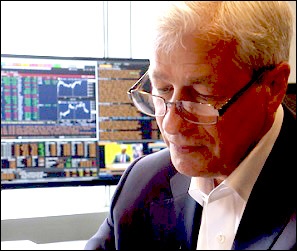By Pam Martens and Russ Martens: March 17, 2023 ~

Jamie Dimon Sits in Front of Trading Monitor in his Office (Source: 60 Minutes Interview, November 10, 2019)
At 6:33 a.m. this morning, this big, bold headline appeared at the very top of Bloomberg News web page: “How Dimon and Yellen Helped Secure $30 Billion Lifeline for First Republic.” This headline is part of a very long, highly questionable promotion of Jamie Dimon by Bloomberg News as the wunderkind of Wall Street banking.
In reality, under Dimon’s tenure as Chairman and CEO, JPMorgan Chase has been on an unprecedented crime spree, including being charged with five felony counts by the U.S. Department of Justice, and his bank is annually ranked by U.S. banking regulators as well as the Basel Committee on Banking Supervision as the riskiest bank on the planet. (See charts at this link at the U.S. Treasury’s Office of Financial Research. Give the page time to load the charts.)
This morning’s headline at Bloomberg News was clearly meant to suggest that Dimon was the modern reincarnation of John Pierpont (J.P.) Morgan, who famously came to the rescue during the financial panic of 1907 with a private pool of money. The Bloomberg headline refers to the fact that JPMorgan Chase, along with Bank of America, Citigroup and Wells Fargo, each ponied up $5 billion to place as uninsured deposits into the teetering First Republic Bank, which has lost 72 percent of its market value year-to-date (as of yesterday’s close). The balance of the $30 billion came from seven additional banks.
The Federal Deposit Insurance Corporation (FDIC) caps federal deposit insurance at $250,000 per depositor, per bank. The stock market looked at the teacup of $30 billion in rescue money, weighed it against the tsunami of facts in First Republic’s regulatory filings which showed, among other things, that the bank at year end had total deposits of $176.25 billion, of which $119.47 billion (or 68 percent) were uninsured by the FDIC, and said to itself, the last thing First Republic Bank needs is more uninsured deposits. The stock of First Republic Bank (ticker FRC) fell 14.7 percent in after-hours trading.
Another troubling detail is that the securities units of JPMorgan Chase and Bank of America were among the book-running underwriters of a secondary stock offering of 2 million shares of First Republic on or around February 10 of this year. First Republic closed at $135.45 on February 10 versus $34.27 yesterday – meaning these underwriters may have legal exposure. In addition, the same underwriters led an August 1, 2022 sale of shares of First Republic Bank to the public, raising over $400 million for the bank. First Republic’s shares were even higher then, priced at $155.48.
Units of Goldman Sachs and Morgan Stanley were the other two underwriters in both the August and February secondary offerings. Both banks were part of yesterday’s $30 billion “rescue,” contributing $2.5 billion each in uninsured deposits to First Republic.
Michael Bloomberg, the former Mayor of New York, is the majority owner of the publishing and data terminal empire that keeps publishing these slobbering headlines about Jamie Dimon. In 2016, Michael Bloomberg even co-authored an opinion piece with Dimon for the opinion section of Bloomberg News. The same year, the New York Post reported that JPMorgan Chase was the second largest customer of Bloomberg’s data terminal business with 10,000 leases of Bloomberg’s terminals. At the time, the terminals cost around $21,000 each per year or approximately $210 million being forked over by JPMorgan Chase to Michael Bloomberg’s company. Bloomberg’s data terminals are the cash cow of the company.
During JPMorgan Chase’s London Whale scandal in 2012 and 2013, where the bank gambled with bank depositors’ money in exotic derivative trades in London and lost at least $6.2 billion, Michael Bloomberg was Mayor of New York City. Instead of condemning this outrageous risk-taking with federally-insured deposits, Bloomberg was quoted in the Wall Street Journal calling Dimon “a very smart, honest, great executive,” adding “The controls failed. He’ll look at that and fix it.” That statement appeared in May of 2012. The five felony counts followed from 2014 to 2020.
On September 16, 2019, for the first time that anyone on Wall Street can remember, RICO charges were brought against traders at JPMorgan Chase by the U.S. Department of Justice. Its precious metals trading desk was characterized at the time as a racketeering enterprise by the Justice Department. The DOJ couldn’t bring itself to state the name of the bank where the traders were located, calling JPMorgan Chase simply “Bank A.”
On September 29, 2020, the Justice Department brought the fourth and fifth felony counts against JPMorgan Chase. One count involved traders rigging the precious metals markets and the other count was for rigging the U.S. Treasury market. As the Justice Department had done in all the previous felony charges against the bank, it settled the charges with large fines, deferred prosecution agreements, and a probation period. (The bank has had three probation periods since 2014 for criminal activity.) But the Justice Department did one thing on September 29, 2020 that was unprecedented for a felony charge involving the rigging of the U.S. Treasury market. The Justice Department announced the charges without holding its usual press conference and taking questions from reporters.
The Justice Department’s deal was so sweet for a criminal recidivist that it wrote in its deal with the bank that “an independent compliance monitor was unnecessary” despite also revealing that the bank “did not voluntarily and timely disclose to the Fraud Section and the Office the conduct described in the Statement of Facts.”

